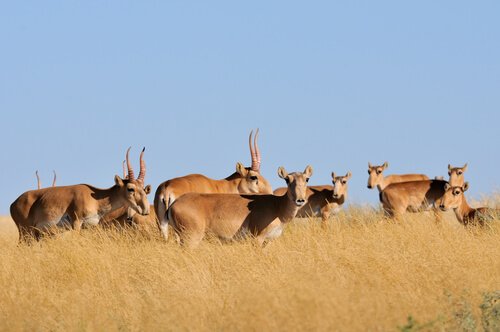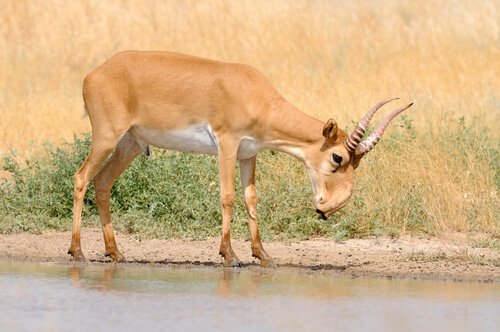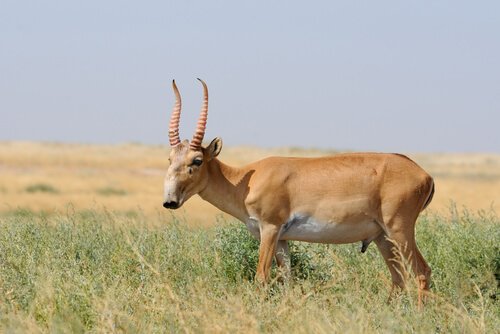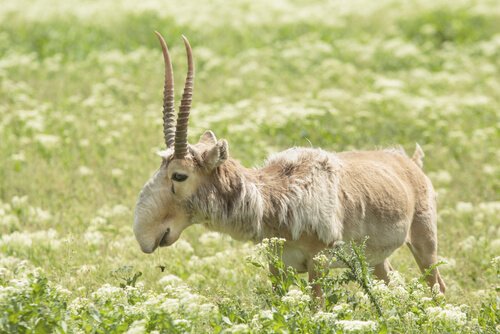The Saiga Antelope: A Species on the Brink of Extinction

The Saiga antelope is an odd animal that has suffered a sharp decrease in population in recent years. Scientists around the world are working tirelessly to prevent it from becoming completely extinct.
Saiga antelopes are migratory and live in central Asian steppes and semi-arid areas. Over the course of an entire year, they migrate through Kazakhstan, Mongolia, southern Russia, Turkmenistan, and Uzbekistan.
They travel something like 600 miles per year, on average. Their migrations are generally from north to south, and back. There are also some scientists who have observed more erratic, nomad-like migrations on some occasions.
Probably the most characteristic aspect of a Saiga antelope is its bloated nostrils. They’re a product of the animal’s fascinating evolution, and work as a way to filter air.
Saiga antelopes have a large, flexible nose that has a complex internal structure with multiple functions. While they migrate, their noses filter out air to keep the dust and dirt they kick up from getting into their lungs.
In the winter, their noses heat up the air before it reaches their lungs, which helps them maintain a much more stable body temperature.

Once spring comes, the females migrate to mating areas. These areas have been the exact same for dozens of years: wide pastures with tall grass.
Unfortunately, illegal poaching is still a major threat to the Saiga antelope population. Their horns sell at a very high price on the black market. In China, their horns have a very important traditional value.
The mass deaths of the Saiga antelope
Much to the chagrin of various wildlife conservation groups, illegal poaching isn’t the only threat to the Saiga antelope. There’s also a silent enemy that has managed to wipe out over 90% of their population over the years.
In 2015, roughly 200,000 Saiga antelopes died all of a sudden over the course of just a few days. Researchers were horrified when they witnessed this, because thousands of them just collapsed for no apparent reason all along the prairies of Kazakhstan.
They were all together in their usual mating places when the disaster began to unfold. Many different experts, including veterinarians, zoologists, and ecologists, among others, said that they had never seen anything like it.

After several analyses, researchers found that the cause of death was a severe bacterial infection in their bloodstream. The infection caused severe internal bleeding, and of course, septicemia, or bacterial blood poisoning.
Recent studies have shown that the lethal bacteria’s spread was caused by the climate at that time: extremely humid and too hot. After studying the historical evidence by looking at previous research into these antelopes, researchers came to a surprising conclusion.
The 2015 disaster isn’t the only time a massive number of Saiga antelopes have died in a short span of time. A major part of their population has died suddenly several times in history.
After looking at the evidence, the researchers realized that every time this happened, there were similar weather conditions. But how exactly did that humid, hot weather lead to the widespread illness?
Global climate change, migration, and infectious disease
Climate change is something that has started to worry many governments and people around the world. It’s also worth remembering that climate change doesn’t just impact humans.
The acceleration of climate change ever since the industrial revolution has had some serious consequences for flora and fauna all over the world. The changes in climate (usually an increase in temperature) have forced many species to migrate to areas that are better suited to their survival.

Lots of plants and animals around the world are reacting to the increased temperatures by moving to cooler climates. This means that a lot of disease-carrying insects are moving too.
As temperatures rise and climate patterns change, so do rainy periods and patterns. For example, diseases related to rain in tropical areas–usually from mosquitoes–have started to spiral out of control.
The problems of warm climates
Scientists have known for a long time that warm climates are a perfect environment for disease to spread. Bacteria multiplies much faster in warm, damp areas.
The rise in temperature and change to rain patterns affects animals in different ways, depending on their biology and how well they can tolerate the changes.
In the case of the Saiga antelope, the bacteria responsible for their mass deaths are being found in their nostrils. We now know that it was the rise in temperature that caused the rapid spread of these bacteria and what killed so many of these antelopes.
If we, as a species, want to help to keep animals like the Saiga antelope alive, we need to reduce our production of harmful greenhouse gases, among many other things. They’re really just one of a countless many whose survival will depend on how we respond to climate change.
All cited sources were thoroughly reviewed by our team to ensure their quality, reliability, currency, and validity. The bibliography of this article was considered reliable and of academic or scientific accuracy.
- Kock, R.; Orynbayev, M.: Robinson, S. (2018) Saigas on the brink: Multidisciplinary analysis of the factors influencing mass mortality events. Science Advances, Vo. 4.
- Altizer, S.; Ostfeld, R. (2013) Climate Change and Infectious Diseases: From Evidence to a Predictive Framework. Science, Vol. 341.